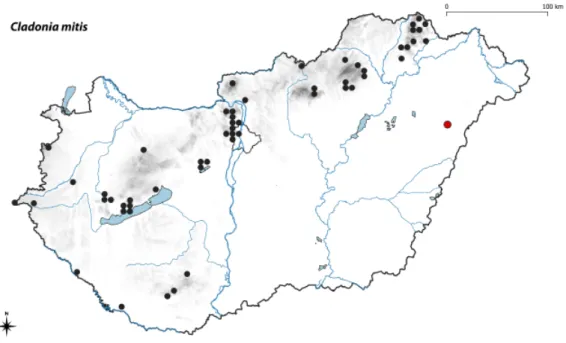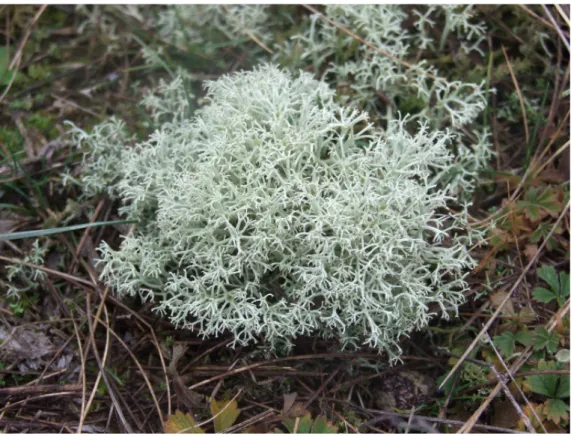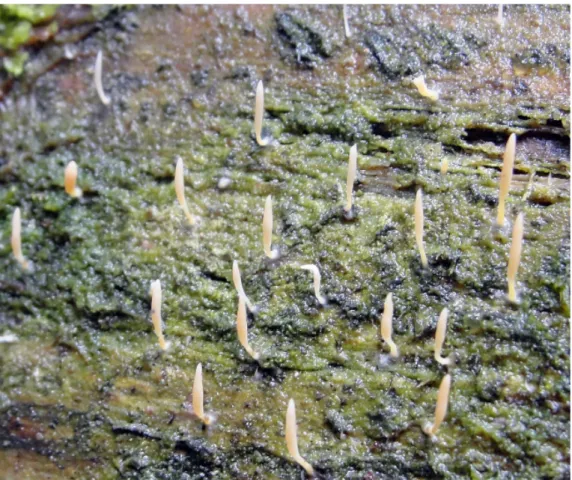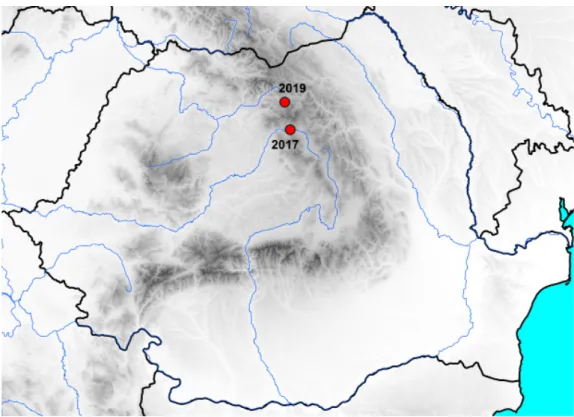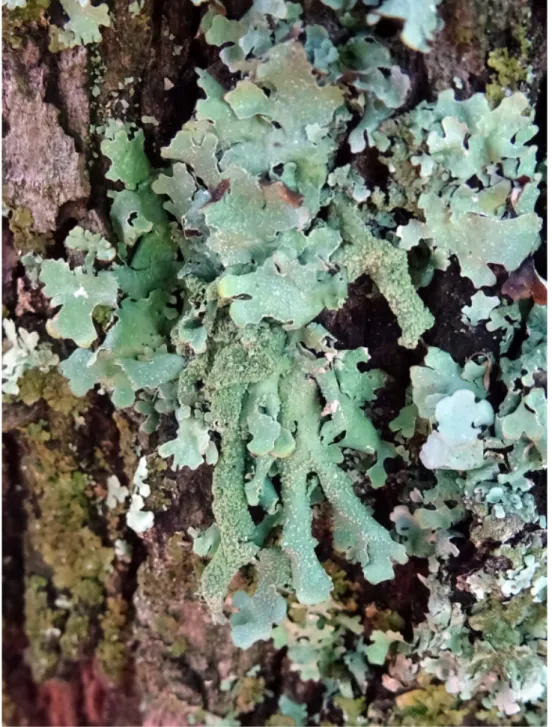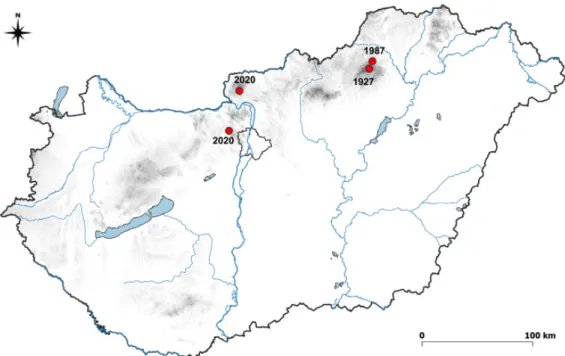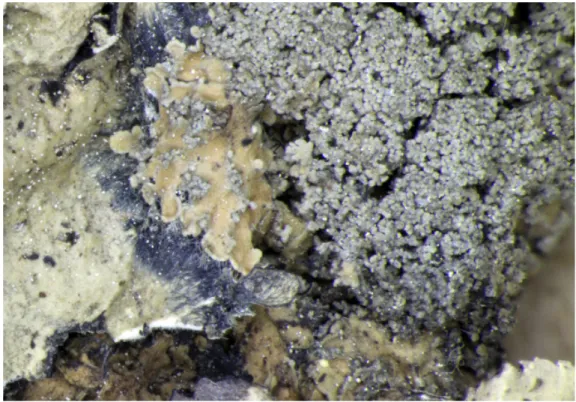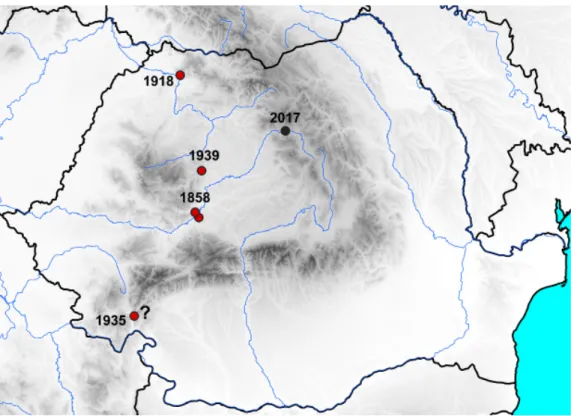TAXONOMICAL AND CHOROLOGICAL NOTES 12 (126–136)
Beáta Papp
1, Peter Erzberger
2, László Lőkös
3, Erzsébet Szurdoki
4, Csaba Németh
5, Krisztina Buczkó
6, Mária Höhn
7,
Rebeka Aszalósné Balogh
8, Kornél Baráth
9, Gábor Matus
10, Dániel Pifkó
11and Edit Farkas
121, 3, 4, 6Department of Botany, Hungarian Natural History Museum
H–1431 Budapest, Pf. 137, Hungary; 1papp.beata@nhmus.hu, 3lokos.laszlo@nhmus.hu,
4szurdoki.erzsebet@nhmus.hu, 6buczko.krisztina@nhmus.hu
2Belziger Str. 37, D-10823 Berlin, Germany; erzberger.peter@gmail.com
5GINOP Sustainable Ecosystems Group, Centre for Ecological Research H–8237 Tihany, Klebelsberg Kuno út 3, Hungary; nemetcsaba@gmail.com
7Department of Botany and Soroksár Botanical Garden, Faculty of Horticultural Science, Szent István University, Budapest, Hungary; hohn.maria@kertk.szie.hu
8, 10Department of Botany, Institute of Biology and Ecology, Faculty of Science and Technology,
University of Debrecen, H–4032 Debrecen, Egyetem tér 1, Hungary; 8 beca002@gmail.com,
10matus.gabor@science.unideb.hu
9Department of Biology, Savaria Campus, Eötvös Loránd University H–9700 Szombathely, Károlyi Gáspár tér 4, Hungary; barath.kornel@ttk.nyme.hu
11National Educational Library and Museum 1087 Budapest Könyves Kálmán krt. 40, Hungary
12Institute of Ecology and Botany, MTA Centre for Ecological Research H–2163 Vácrátót, Alkotmány u. 2–4, Hungary; farkas.edit@okologia.mta.hu
Papp, B., Erzberger, P., Lőkös, L., Szurdoki, E., Németh, Cs., Buczkó, K., Höhn, M., Aszalósné Ba- logh, R., Baráth, K., Matus, G., Pifk ó, D. & Farkas, E. (2020): Taxonomical and chorological notes 12 (126–136). – Studia bot. hung. 51(1): 77–98.
Abstract: Th e present part of the series provides new records of 11 taxa, among them fi ve lichen- forming fungi and six bryophytes. One lichen-forming fungus was discovered as new species in Hungary (Parmeliella triptophylla), however it was collected 115 years ago, this species should be considered as an extinct species in Hungary. One bryohyte is newly reported from Hungary (Bra- chy theciastrum olympicum). Th e occurrence of one lichen-forming fungus (Parmelia submontana) and two bryophyte species (Palustriella falcata, Ptychostomum pseudotriquetrum var. bimum) was confi rmed in Hungary. Amendments to the known distribution of lichen-forming fungi species are reported from Hungary (Cladonia mitis) and Romania (Multiclavula mucida, Xanthoparmelia protomatrae) and three bryophytes from Hungary are also reported (Callicladium haldanianum, Codonoblepharon forsteri, Ephemerum cohaerens).
Key words: Amblystegiaceae, Brachytheciaceae, Bryaceae, bryophyte, Callicladiaceae, Cladonia- ceae, Clavulina ceae, Hungary, lichen-forming fungi, Orthotrichaceae, Pannariaceae, Parmeliaceae, Pottiaceae, Romania
PAPP, B. et al.
78
INTRODUCTION
Th is paper is the twelft h part of the series launched in Studia botanica hun- garica focusing on the new chorological records, nomenclature, and taxonomy of plant species from algae to vascular plants and fungi (Barina et al. 2015, 2020, Csiky et al. 2017, Deme et al. 2019, Király et al. 2019a, b, Matus et al. 2018, Mesterházy et al. 2017, Papp et al. 2016, Schmidt et al. 2018, Takács et al.
2016).
MATERIAL AND METHODS
Nomenclature and taxonomy of lichen-forming fungi and bryophytes fol- low CABI (2020), Robert et al. (2020) and Hodgetts et al. (2020), respective- ly. Codes of the Central European Flora Mapping grid are in square brackets.
Abbreviations of herbaria follow Thiers (2017).
NEW RECORDS WITH ANNOTATIONS Lichen-forming fungi
(126) Cladonia mitis Sandst. (Cladoniaceae)
Hungary, Hajdú-Bihar County, Nyírség, Hajdúsámson: Martinkai-legelő (on EOTR 69-221 map as Csernusz-puszta), west of forest lot 135/A, 47.57975° N 21.80393° E, alt.: 134 m, 24.11.2018, leg.: G. Matus, R. Balogh, det.: L. Lőkös, E. Farkas, N. Varga (DE 6267, BP 96764).
Former Hungarian records of this ‘reindeer lichen’ are predominantly from regions of higher altitude and of higher precipitation like the Northern Mountain Range (Zemplén, Bükk, and Cserhát), the Transdanubian Middle Range (Pilis, Velence, Bakony, and Balaton Uplands), as well as the Mecsek Mts in South and Őrség in West Hungary, respectively (Fig. 1, Farkas et al. 2012, Varga et al.
2014, Verseghy 1994). Th e occurrence of the species in the easternmost part of Hungary at such a low altitude and under continental climate is remarkable.
Th e recent record is new for the Nyírség, as well as for the whole Eupan- nonicum (Hungarian Plains). HPTLC analysis for chemical substances was ap- plied in solvent system C according to Arup et al. (1993) and has indicated the presence of usnic acid and rangiformic acid.
Cladonia mitis (Figs 2–3) is a legally protected lichen species in Hungary
[18/2008(VI.19) KvVM, 83/2013.(IX.25.) VM] and is a species of community in-
terest [Habitat Directive 92/43 EEC, annex V]. Th e specimens have been collect-
ed on the northern slope of a sand dune, in Festucetum vaginatae, on acidic sandy
soil, at a military training area abandoned decades ago (along an eroded infantry
Fig. 1. Known occurrences of Cladonia mitis in Hungary.
Fig. 2. Cladonia mitis in Hajdúsámson, Martinkai-legelő (Nyírség, E Hungary).
PAPP, B. et al.
80
trench). Accompanying cryptogams were Cladonia convoluta, C. cf. fi mb riata, C.
magyarica, C. rangiformis, C. subrangiformis, Brachythecium albicans, Polytrichum piliferum, together with vascular plants as Carex hirta, Centaurea micranthos, Chondrilla juncea, Crepis rhoeadifolia, Cynodon dactylon, Euphorbia cyparissias, Equisetum ramosissimum, Eryngium campestre, Hieracium pilosella, Hypericum perforatum, Hypochoeris radicata, Luzula campestris, Poa bulbosa, Potentilla are- naria, Rumex acetosella, Vicia lathyroides.
Work of R. A. Balogh has been supported by the ÚNKP-19-3-I-DE-392 New National Excellence Program of the Ministry for Innovation and Technology, and also by the project of National Research, Development and Innovation Offi ce, NKFI K124341.
R. A. Balogh, G. Matus, L. Lőkös, N. Varga and E. Farkas (127) Multiclavula mucida (Pers.) R. H. Petersen (Clavulinaceae)
Romania. Suceava County, Municipiul Vatra Dornei, Commune Poiana Stampei, Dorna val- ley at village Căsoi, in Rezervația naturală ‘Tinovul Mare Poiana Stampei’, on heavily wet stump of a fallen coniferous tree. Lat.: 47.299728° N, long.: 25.114134° E, alt.: ca 920 m a.s.l. Leg.: L. Lőkös, D. Pifk ó, 06.08.2019. [BP 96765] (Fig. 4).
Fig. 3. Cladonia mitis in Hajdúsámson, Martinkai-legelő (Nyírség, E Hungary).
Th e fi rst Romanian record of Multiclavula mucida was reported from the Mureş valley (Eastern Carpathians, Romania) in 2018 (Schmidt et al. 2018). Th e new record from Poiana Stampei is the second known occurrence from Romania at the northwestern border of the Călimani Mts ca 40 km from the fi rst locality (cf. Ciurchea 2004, Eliade 1965) (Fig. 5).
Due to its botanical values this peat bog area received a reservation status in 1955 (nr. 1625), and legal protection in 2000 (nr. 5/2000, pos. 2715, Annex I). Later it became also a Natura 2000 area (ROSCI0247) in 2007, and partly a Ramsar site (nr. 2003) in 2012. It is the largest peat bog area in Romania, its wooded (Betula, Picea, Pinus) vegetation can supply continuous humid condi- tions for the rather hygrophilous cryptogams.
Th e fi eldwork was supported by the project NKFI K119208, and laboratory work also by the project NKFI K124341.
L. Lőkös, E. Farkas, M. Höhn, D. Pifk ó, E. Szurdoki and K. Buczkó
Fig. 4. Multiclavula mucida in reserve ‘Tinovul Mare Poiana Stampei’ (Eastern Carpathians, Romania) (Photo: Lőkös, L., 2019)
PAPP, B. et al.
82
(128) Parmelia submontana Hale (Parmeliaceae)
Hungary. Pest County, Börzsöny Mts, southern slope of Mt Magas-Tax at ‘Taxi nyiladék’, ca 3.1 km NE of Szokolya-Királyrét, on bark of an old Quercus petraea in an oak wood. Lat.: 47.911818°
N, long.: 18.946406° E, alt.: ca 450 m a.s.l. Leg. E. Farkas and L. Lőkös, 06.06.2020. [BP 96766] (Fig.
6). – Hungary. Pest County, Buda Mts, SE side of Mt Meszes-hegy above valley Cseresznyés-völgy, ca 4,7 km WNW of Nagykovácsi, on bark (Fraxinus ornus). Lat.: 47.587824° N, long.: 18.821284°
E, alt.: ca 380 m a.s.l. Leg. L. Lőkös, 12.07.2020. [BP 96767].
Parmelia submontana H ale is a lichen species with predominantly European distribution, a Mediterranean-South-European montane element (Hale 1987, Schindler 1975, 1997). Earlier it was considered as an infraspecifi c taxon of Parmelia sulcata Tayl. with elongated lobes (e.g. Nylander 1860, Zahl- bruckner 1907, 1927). It was accepted at species level by Mason E. Hale pro- viding a clear interpretation of its diagnostic characters, i.e. the long, hanging, separate, strap-shaped, little branched lobes; numerous, mostly laminal, or- bicular soralia; granular to isidioid soredia; small, effi gurate pseudocyphellae pattern; sparse, mostly simple rhizines (Hale 1987). Since the early synonym names for this taxon proved to be illegitim from nomenclatural point of view, a new, legitim name was also given (Hale 1987). Its position in the Parmelia
Fig. 5. Known occurrences of Multiclavula mucida in Romania.
saxatilis clade in the phylogenetic tree was confi rmed by molecular genetic studies, its clear separation from other really isidiate species was well supported (Ossowska et al. 2018).
Fig. 6. Parmelia submontana, growing on Quercus bark (Magas-Tax, Börzsöny Mts, Hungary) (Photo: Farkas, E.)
PAPP, B. et al.
84
Th e fi rst Hungarian specimen of Parmelia submontana was collected by F. Fóriss (as P. sulcata) from beech bark at ‘Kismező’ in the Bükk Mts in 1927 (revised later as P. contorta by K. Verseghy). Th e second known locality was re- ported also from the Bükk Mts (‘Osztra-tető’) by Kiszely Vámosi et al. (1989) (as Parmelia contorta). Both specimens were published under the name Parmelia contorta by Verseghy (1994).
Th e new Hungarian localities of Parmelia submontana were found 1) in Mt Magas-Tax in the Börzsöny Mts during the 20th Hungarian Biodiversity Days in 2020, where it grew on oak trees; and 2) in Mt Meszes-hegy, Buda Mts, growing on ash tree. P. submontana might be one of the Mediterranean lichen species, ex- pectedly spreading further in Hungary due to global climatic changes. It is new to both the Börzsöny and the Buda Mts. Based on its rare occurrence (Fig. 7) it is suggested for ‘vulnerable’ category in the Hungarian lichen red list.
Laboratory investigation was supported by the project NKFI K124341.
E. Farkas and L. Lőkös (129) Parmeliella triptophylla (Ach.) Müll. Arg. (Pannariaceae)
Hung. med. In monte Dobogókő. Leg.: Tomek, J., 24.04.1905 [BP 83137 sub Parmelia tricho- tera]. – New to Hungary!
Th e Pannariaceae family was represented in Hungary only with 3 species, i.e.
Fuscopannaria leucophaea (11 localities), Moelleropsis nebulosa (9 localities), and
Fig. 7. Known occurrences of Parmelia submontana in Hungary.
Fig. 8. Parmeliella triptophylla growing on Parmotrema perlatum thallus in Dobogókő (Visegrád Mts, Hungary) (BP 83137).
Fig. 9. Old occurrence of Parmeliella triptophylla in Hungary.
PAPP, B. et al.
86
Protopannaria pezizoides (3 localities) (Kőfaragó-Gyelnik 1940, Szatala 1930, Verseghy 1994). All of them are rare, with a few specimens only, mostly from the fi rst half of the last century (before 1964).
Parmeliella triptophylla is a widespread cool-temperate species, circumtem- perate in the Northern Hemisphere, growing in humid montane forests, usually on old shaded trees (Jørgensen 1987, 2007). It is characterised by the wide black prothallus, and the coralloid isidia.
Th e Hungarian specimen was found incidentally, during the revision of some old Parmelia trichotera specimens. Parmeliella triptophylla was growing on the thallus of Parmotrema perlatum (Fig. 8), and it was misidentifi ed as Parmelia dubia. Th e specimen was collected 115 years ago, when climatic conditions in the Dobogókő region (Fig. 9) were probably more favourable for this species.
Parmeliella triptophylla should be considered as an extinct species in Hungary in the Hungarian lichen red list.
Th e laboratory work was supported by the project NKFI K124341.
L. Lőkös and E. Farkas (130) Xanthoparmelia protomatrae (Gyeln.) Hale (Parmeliaceae)
Romania. Mureş County, Lunca Bradului (Palotailva), steep siliceous rocky ridges in Mureş valley at the southwestern border of the Călimani Mts (Eastern Carpathians), ca 1.1 km ENE of Neagra, on exposed siliceous rock. Lat.: 46.969205° N, long.: 25.170631° E, alt.: ca 705 m a.s.l. Leg.:
Lőkös, L., Höhn, M. and Szurdoki, E., 26.09.2017 [BP 96768]. – Romania. Mureş County, Lunca Bradului (Palotailva), steep siliceous rocky ridges in Mureş valley at the southwestern border of the Călimani Mts (Eastern Carpathians), ca 1.1 km ENE of Neagra, on exposed siliceous rock. Lat.:
46.968895° N, long.: 25.170852° E, alt.: ca 685 m a.s.l. Leg.: Lőkös, L., Höhn, M. and Szurdoki, E., 26.09.2017 [BP 96769]. – New to the Călimani Mts (Eastern Carpathians).
Old Romanian records (before 1940): Hungaria. Com. Szatmár. In rupi- bus trachyticis in Valea mare prope pag. Nagysikárló. Alt. ca. 230–270 m s. m.
Leg.: Fóriss, F. (4534), 17.06.1918. [herb. Kazinczy Ferenc Múzeum] (Fóriss 1937 as Parmelia protomatrae f. crustaeformis). – Hungaria. Albae Carolinae, Pulverthurm. Leg.: Haynald, L., 26. Aug. 185x [ca 1852–1863]. [BP 21625]
(Gyelnik 1931 as Parmelia protomatrae var. tenuior, Hale 1974, 1990, Krog 1978). – Transsilvania, Domugledicum, Herkulesfürdő, in valle Cserna Patak, ad saxa silicea. Leg.: V. Gyelnik, 21.07.1935. [herb. n.a.] (Gyelnik 1938 as Parmelia protomatrae f. crustaeformis). – In corticibus Alnorum. Váradja. Leg.: Haynald, L. (Crypt. 4254), 12.04.1858. [BP 23608]. – Transsilvania, distr. Turda. Fissura Cheia Turzii, in rupibus porphyritico-tuff aceis, sub “Povârnişul Pop”. Alt. cca 480 m s. m. Leg.: Cretzoiu, P., Nyárády, E. I., Pteaneu, P., 26.10.1939. [BP 21684]
(Flora Romaniae exsiccata, no. 1827). (Borza 1940 as Parmelia conspersa).
Based on its special chemical character Xanthoparmelia protomatrae was de-
scribed by Vilmos Gyelnik from the Visegrád Mts (Hungary) (Gyelnik 1931, as
Parmelia protomatrae). It was also accepted at species level (as Xanthoparmelia protomatrae) by Krog (1978), Hale (1990), Verseghy (1988, 1994), as well as in modern molecular genetic papers (Blanco et al. 2004, Crespo et al. 2010).
Xantho parmelia protomatrae was also treated as a species in the fi rst European checklist of parmelioid lichens (Hawksworth et al. 2008), and it was reported from many countries worldwide: Armenia, Austria, Belgium, China, Croatia, Czech Republic, France, Germany, Hungary, Italy, Mongolia, Netherlands, Norway, Portugal, Roma nia, Russia, Saudi Arabia, Serbia, Slovakia, Spain, Turkey, Ukraine, United King dom (Gasparyan et al. 2015, Hawks worth et al. 2008, Huneck et al. 1992, Krog 1978, Spier 1992, Stor deur et al. 2018).
However, it was considered as a synonym (an infraspecifi c taxon) of morphologi- cally similar species (e.g. X. somloensis, X. taractica) by some authors (Ciurchea 2004, Krog 1978, Santesson 1993).
A new form of the species (Parmelia protomatrae f. tenuior) was described from ‘Alba Carolina’ by Gyelnik (1931). Alba Carolina is a historical name for the old Hungarian town, Gyulafehérvár, which is today Alba Iulia in Romania.
Th is Romanian locality was erroneously cited as Hungarian locality (Krog 1978,
Fig. 10. Distribution of Xanthoparmelia protomatrae in Romania (? = literature record, location of the specimen is unknown).
PAPP, B. et al.
88
Hale 1990), and it was also overlooked and omitted in Romanian lichen check- lists (Moruzi et al. 1967, Ciurchea 2004). In addition, the type specimen of Parmelia protomatrae f. tenuior was erroneously revised as Parmelia taractica f.
angustiphylla by Verseghy (1988). Further Romanian records were published from Nagysikárló (today Cicârlău) by Fóriss (1937) (the only X. protomatrae record cited from Romania in Moruzi et al. 1967), and from Herkulesfürdő (Băile Herculane) by Gyelnik (1938). However, Xanthoparmelia protomatrae was synonymised with X. somloensis (now is the synonym of X. stenophylla) in the latest Romanian checklist (Ciurchea 2004), so X. protomatrae as an independ- ent species has practically disappeared from the Romanian lichen fl ora.
Based on the three old published records, further two old unpublished (Váradja (= Oarda) 1858; Turda 1939) and two recently collected specimens we can confi rm the presence of X. protomatrae in Romania (Fig. 10).
Th e fi eldwork was supported by the project NKFI K119208, and laboratory work also by the project NKFI K124341. Many thanks to Gábor Hegyessy and Dalma Dobronoki (Kazinczy Ferenc Múzeum, Sároraljaújhely, Hungary) for the kind help in localisation of X. protomatrae specimen from Nagysikárló.
L. Lőkös, K. Buczkó, M. Höhn, E. Szurdoki and E. Farkas Bryophytes
(131) Brachytheciastrum olympicum (Jur.) Vanderp. et al. (Brachytheciaceae)
Hungary, Hajdú-Bihar County, [8392.3] at Hortobágyi halastó lake near Hortobágy village, on soil, N 47.609472°, E 21.069208°, 85 m, 12.04.2010, leg. B. Papp, det. B. Papp and P. Erzberger as Brachy thecium velutinum var. salicinum (Schimp.) Mönk., rev. B. Papp in 2019 (BP 189926), conf.
M. Igna tov in 2019.
It is reported here for the fi rst time in Hungary. In the past Brachythecium olym pi cum was synonymised with B. velutinum (Hedw.) Schimp. var. salicinum (Schimp.) Moenk.) (Düll 1985). According to the recent taxonomic treatment Bra chy theciastrum salicinum is elevated to species rank, but B. olympicum has been recognised as a separate species (Hodgetts et al. 2020, Orgaz et al. 2013).
Both species have smooth setae, which distinguish them from their close rela-
tives, B. veluti num and B. dieckii. Th e latter has many leaf cells prorate on the
dorsal side; it has not been recorded in Hungary. B. olympicum has some prorate
cells on the dorsal side of the leaf and a triangular leaf shape, while the leaf cells
of B. salicinum are smooth, not prorate, and the leaf shape is lanceolate. B. olym-
picum lives on rocks and calcareous soil, between 1,300 and 2,200 m above sea
level according to Orgaz et al. (2013). It is known mainly from southern Europe,
e.g. Portugal, France (incl. Corsica), Italy (Sardinia, Sicily), Albania, Bosnia-
Herzegovina, Croatia, Greece, North Macedonia, Romania, Slovenia, European
part of Turkey, Cyprus, Caucasus, and SE Russia (Hodgetts and Lockhart 2020), but some records are doubtful due to the former synonymy with B. salici- num. It is vulnerable (VU) in Europe according to the new European red list of bryophytes (Hodgetts et al. 2019). In contrast with most of the earlier known habitats of the species the Hungarian record originates from low elevation. Th e climate of the site is characterised by high continentality, large daily and yearly temperature fl uctuation, and low precipitation (500 mm/year).
B. Papp (132) Callicladium haldanianum (Grev.) H. A. Crum (Callicladiaceae)
Hungary, Borsod-Abaúj-Zemplén County, [7688.4] Kismohos bog at Kelemér village, on the base of Betula tree, N 48.337222°, E 20.425417°, 320 m, 23.06.2017, leg. et det.: B. Papp, P. Erz- berger and E. Szurdoki (BP 192923, B-Erzberger 23514); and 17.08.2018, leg. et det.: B. Papp and E. Szurdoki (BP 195011).
It is a northern subcontinental element (Düll 1985). Th e species was re- ported for the fi rst time from Hungary by Erzberger et al. (2016). It was found in 2015 in the western part of Hungary in Somogy County, in an alder swamp at Lake Baláta on rotting wood [9669.3]. Our record collected in 2017 in Kismohos bog represents the second locality of the species. It was found only on one birch tree. Later on, in 2018 and 2019 during bryophyte monitoring work conducted in the bog, several other well-developed patches of C. haldanianum have been found on tree bases and on humus rich soil around trees (Papp and Szurdoki 2019). It seems that the species is spreading in the bog occupying more and more suitable trees. Th e spread of the species on a wider scale was also reported from Central European countries, e.g. in Poland (Stebel 2013) and in Germany around Berlin (Klawitter 1993, Meinunger and Schröder 2007). Th e species is similar to Hypnum cupressiforme Hedw. and they can grow in the same habitat.
Hence, C. haldanianum can easily be overlooked, but its leaves are only slightly secund compared with Hypnum cupressiforme. Microscopically it can be identifi ed easily, having large alar cells, which form more or less distinct auricles.
Th e fl ora of Kismohos Lake is well-explored. Several detailed botanical in-
vestigations, including fl oristical and vegetation surveys have been conducted
there. Bryophytes have also been considered in many studies (Czenthe 1985,
Kröel-Dulay 1995, Lájer 1998, Zólyomi 1931). Earlier Hungarian bryolo-
gists have oft en visited the site. For example, Ádám Boros visited it four times be-
tween 1924 and 1960 (Boros 1915–1971) and published several papers (Boros
1924, 1926, 1940, 1951, 1964). Later on, as a part of the Hungarian Biodiversity-
monitoring System, monitoring of bryophyte assemblages has been carried out
from 2000 onwards (Ódor et al. 2000, 2006, 2013, Papp et al. 2001, 2004, 2007,
2010a, 2016). During so many detailed investigations it is unlikely that the spe-
PAPP, B. et al.
90
cies would not have been recognised earlier, if it had occurred there. Hence, its appearance and spread in Hungary are recent processes.
B. Papp, P. Erzberger and E. Szurdoki (133) Codonoblepharon forsteri (Dicks.) Goffi net (Zygodon forsteri (Dicks.) Mitt.) (Orthotrichaceae)
Hungary, Pest County, [8579.1] north of Biatorbágy, Kálvária-hill, mixed forest with Quer- cus cerris in a dendrotelma of a Quercus cerris, N 47.49236°, E 18.84311°, 260 m, 18.05.2018, leg.
et det.: P. Erzberger (B-Erzberger 24592), N 47.4922°, E 18.8430°, 270 m, 21.05.2018, leg. et det.:
P. Erzberger (BP 194730). Hungary, Nógrád County, [8083.1] Cserhát Mts, Bokor village, Bokri- hill, in coppiced oak forest, N 47.9074°, E 19.5587°, 288 m, 18.07.2019, leg. et det.: Cs. Németh (Herbarium of Csaba Németh, HCsN 9582, 9585). – Hungary, Veszprém County, [9073.1] Balaton Upland region, Balatonfüred (Balatonarács), Koloska-valley, in coppiced oak forest, N 46.9847°, E 17.8922°, 176 m, 08.29.2019, leg. et det.: Cs. Németh (Herbarium of Csaba Németh, HCsN 9609).
– Hungary, Nógrád County, [8181.2] Cserhát Mts, between Alsópetény and Legénd in an oak for- est, in a dend rotelma of a Quercus petraea, N 47.8712°, E 19.2777°, 400 m, 19.07.2019, leg. et det.: B.
Papp, B. and P. Erzberger (BP 195400, B-Erzberger 26635).
Th is atlantic-sub-Mediterranean species (Düll 1985) was reported for the fi rst time in Hungary in 2016 (Papp and Sinigla 2017). It was found in a knot- hole of a Quercus cerris tree in a managed Quercus cerris, Quercus petraea forest in Balaton Upland region [9171.1]. In 2017 the site was revisited and another tree inhabited by Codonoblepharon forsteri was discovered (Papp and Szurdoki 2017). Th e species usually grows in knot-holes (dendrotelma) or other hollows of trees, where water runs down on the bark, and oft en on callus tissue. It has a very scattered distribution and is red-listed in many countries where it occurs, and endangered (EN) in Europe according to the new European red list of bryophytes (Hodgetts et al. 2019). Th e Hungarian sites are thermophilous oak forests, where usually another rare species protected in Hungary, Anacamptodon splachnoides oc- curs, which lives in the same microhabitat (knot-holes). Sometimes they can live on the same tree or even in the same knot-hole. In some localities, like Bokri-hill in the Cserhát Mts, C. forsteri has quite well-developed populations, colonising ca 20 trees. Earlier Hungarian bryologists have not reported this species despite the fact that they collected and recorded A. splachnoides in more than 30 sites in the country in various mountain areas (Boros 1915–1971, 1968). We suppose the appearance and spread of the species in Hungary are recent and ongoing events.
Cs. Németh, P. Erzberger and B. Papp (134) Ephemerum cohaerens (Hedw.) Hampe (Pottiaceae)
Hungary, Pest County, [8879.3] Danube bank at Lórév, on soil, N 47.113639°, E 18.888472°, 100 m, 21.09.2018, leg. et det.: B. Papp (BP 194975). – Pest County, [8380.2] Szentendrei-sziget, Szigetmonostor, Vízkelő, N 47.678167°, E 19.092389°, 100 m, 20.10.2018, leg. et det.: B. Papp (BP 194966). – Komárom-Esztergom County, [8178.4] Esztergom, Danube bank at Búbánat-völgy,
N 47.81397°, E 18.81611°, 110 m, 10.11.2018, leg. et det.: B. Papp (BP 195023). – Komárom-Eszter- gom County, [8179.3] Pilismarót, Danube bank near the ferry to Szob, N 47.80994°, E 18.87142°, 105 m, 10.11.2018, leg. et det.: B. Papp (BP 195030). – Pest County, [8380.2] Göd, Danube bank, N 47.69619°, E 19.12943°, 95 m, 11.11.2018, leg. et det.: B. Papp (BP 195035). – Fejér County, [9179.2] Danube bank at Kisapostag, on soil, N 46.865306°, E 18.922361°, 95 m, 13.10.2019, leg. et det.: B. Papp and P. Erzberger (BP 195401, B-Erzberger 26973, 26974). – Tolna County, [9179.4]
Danube bank at Dunaföldvár, on soil, N 46.818528°, E 18.922778°, 100 m, 13.10.2019, leg. et det.:
B. Papp (BP 195402). – Fejér County, [9079.2] Dunaújváros, Szalki island at the Danube, on soil, N 46.982806°, E 18.947028°, 95 m, 16.10.2019, leg. et det.: B. Papp (BP 195403). – Bács-Kiskun Coun- ty, [9079.4] Dunavecse, Danube bank, on soil, N 46.92153°, E 18.96622°, 90 m, 21.10.2019, leg. et det.: P. Erzberger (B-Erzberger 27024). – Nógrád County, [8180.3] Danube bank at Kismaros, on soil in a Salicetum, N 47.821417°, E 19.010417°, 105 m, 19.10.2019, leg. et det.: B. Papp, Cs. Németh and P. Erzberger (BP 195404, B-Erzberger 27014).
In the 20th century, the species was found only once in Hungary at the Danube near Érd by Förster (Boros 1968, Orbán and Vajda 1983). In Hungary, E. cohae rens is a protected species; in the latest checklist and red list of Hungarian bryophytes (Papp et al. 2010b) it was placed in the data defi cient category (DD), which means that this taxon had no recent data. According to the new European red list of bryophytes (Hodgetts et al. 2019), it is rare and threatened in Europe, being in the vulnerable category (VU). It is a lowland species with western and Central European distribution, appearing mainly along rivers, like Danube, Rhine, Rhone, and their tributaries (Bijlsma et al. 2012). In many countries, where it oc- curs, E. cohaerens is red-listed (regionally extinct (RE) in Austria and in Slovenia;
critically endangered (CR) in Spain, in Switzerland and in Romania; endangered (EN) in Great Britain, in Germany and in Poland; vulnerable (VU) in Ireland and in Slovakia; data defi cient (DD) in the Czech Republic). Apart from these, it is known from the Azores, France, Italy, Belgium, the Netherlands and Croatia (Hodgetts and Lockhart 2020). In Hungary its main habitat is clayey soil un- der willow trees or even in the root mat of willows. Th is is a higher zone of the riv- erbank, which is inundated only occasionally. Th e species has a seasonal appear- ance, mostly from September to December in Hungary, when the water level is usually low. Apparently, it is not rare along the Hungarian Danube section, which is evidenced by several collections made during the last years. Certainly, it was overlooked and under-collected in the past due to its small size and seasonality.
B. Papp, P. Erzberger and Cs. Németh (135) Palustriella falcata (Brid.) Hedenäs (Cratoneuron commutatum (Hedw.) Roth var. falcatum (Brid.) Moenk.) (Amblystegiaceae)
Hungary, Veszprém County, [8871.1] Bakonygyepes, Széki forest, in a wetland, N 47.155472°, E 17.510694°, 260 m, 09.08.2019, leg. et det.: B. Papp (BP 195405, Herbarium of Csaba Németh, HCsN 9595, B-Erzberger 26718). – Vas County, [8664.2] Kőszeg, spring area below Árpád-forrás, N 47.37693°, E 16.47708°, 460 m, 06.10.2018, leg. et det.: P. Erzberger and K. Baráth (B-Erzberger 25559).
PAPP, B. et al.
92
In Orbán and Vajda (1983) this is an infraspecifi c taxon, mentioned as a variety of Cratoneuron commutatum. However, P. falcata was elevated to species rank by Hedenäs (1992). According to Düll (1985) it is a species of the temper- ate zone of Europe, living in similar habitats as P. commutata, in calcareous source areas, wetlands and streams. P. falcata diff ers from P. commutata by having an irregularly branched stem with no or very few paraphyllia and rhizoids. Earlier records are scarce from Hungary (ca 5–6 localities) and it is supposed that degra- dation and drying of wetlands induced by anthropogenic infl uence and climate change destroyed these populations. Nowadays, the only documented known lo- calities of the species are in Széki forest and Kőszeg Mts.
B. Papp, P. Erzberger, Cs. Németh and K. Baráth (136) Ptychostomum pseudotriquetrum var. bimum (Schreb.) Holyoak et N.
Pedersen (Bryum pseudotriquetrum var. bimum (Schreb.) Lilj., Bryum bimum (Schreb.) Turner) (Bryaceae)
Hungary, Zala County, [9069.4] Sümegprága, abandoned basalt quarry, in earth-fi lled fi s- sures of basaltic rock, N 46.93456°, E 17.28367°, 250 m, 23.10.2015, leg. et det.: P. Erzberger (as Bry- um creberrimum, rev. W. Schröder, B-Erzberger 20920/A). – Veszprém County, [9171.2] between Köveskál and Szentbékkálla, Sásdi-rétek, wetland, 130 m, 04.08.1996, leg. B. Papp (as Bryum pseu- dotriquetrum, rev. P Erzberger and W. Schröder (Erzberger and Schröder 2013), BP 163341).
– Veszprém County, [9170.1] Tapolca, Körtvélyes wetland, N 46.871946°, E 17.395782°, 120 m, 23.05.2020, leg. B. Papp and E. Szurdoki, det. B. Papp (BP 195810). – Veszprém County, [9170.1]
Tapolca (Kalicsmajor), Lesencetomaj wetland, N 46.870256°, E 17.379306°, 120 m, 23.05.2020, leg.
B. Papp and E. Szurdoki, det. B. Papp (BP 195811).
It is mentioned as a separate species being rare in Hungary in Orbán and Vajda (1983), later on it was treated as a variety of Bryum pseudotriquetrum in the Hungarian checklist of Erzberger and Papp (2004), and it was omitted in the last Hungarian checklist and red list (Papp et al. 2010b). Ptychostomum pseudotri- quetrum var. bimum is synoicous, it can be found nearly always with sporophytes;
the spores are usually 15–25 μm, while P. pseudotriquetrum var. pseudotriquetrum is dioicous, sporophytes are rarely produced, and the spores are usually 12–18 μm (Erzberger and Schröder 2013).
P. pseudotriquetrum var. bimum can be found oft en in disturbed habitats; in old quarries, sand pits, in moist meadows, in wetlands, by streams (Erzberger and Schröder 2013). Nowadays, it has only four known locations in Hungary.
Out of them three are wetlands situated in the Balaton-felvidék region.
B. Papp, P. Erzberger and E. Szurdoki
* * *
We are very grateful to the staff of the Calimani National Park, especially to Basarab Bir- ladeanu (director), and to Claudiu Rogojan (biologist) for their kind help and the research permis-
sion in the Calimani Mts, furthermore to Péter Ábrán for his help in the fi eldwork. We also grateful to the Hungarian Biodiversity Research Society for organising the 20th Hungarian Biodiversity Day in the Börzsöny Mts (Hungary).
Összefoglaló: Regionális adatokat közlő rovatunk jelen részében 11 kriptogám faj új elő- fordulásairól számolunk be, melyek közül 5 zuzmó és 6 moha. Egy zuzmófajt először (Parmeliella triptophylla) találtak Magyarország területén, de mivel egy 115 évvel ezelőtt gyűjtött anyagból ke- rült elő, kihaltként kell számon tartani. Egy mohafajt elsőként közlünk Magyarország területéről (Brachytheciastrum olympicum). Korábbi előfordulását erősítjük meg Magyarországon két moha fajnak (Palustriella falcata, Ptychostomum pseudotriquetrum var. bimum) és egy zuzmófajnak (Parmelia submontana). Az ismert elterjedéseket kiegészítő új zuzmó adatokat közlünk Magyar- országról (Cladonia mitis) és Romániából (Multiclavula mucida, Xanthoparmelia protomatrae), valamint mohafajokat Magyarországról (Callicladium haldanianum, Codonoblepharon forsteri, Ephemerum cohaerens).
REFERENCES
Arup, U., Ekman, S., Lindblom, L. and Mattsson, J. E. (1993): High performance thin lay- er chromatography (HPTLC), an improved technique for screening lichen substances. – Lichen ologist 25(1): 61–71. https://doi.org/10.1017/s0024282993000076
Barina, Z., Benedek, L., Boros, L., Dima, B., Folcz, Á., Király, G., Koszka, A., Malatinszky, Á., Papp, D., Pifkó, D. and Papp, V. (2015): Taxonomical and chorological notes 1 (1–19). – Studia bot. hung. 46(2): 205–221. https://doi.org/10.17110/studbot.2015.46.2.205
Barina Z., Molnár Cs., Somogyi G., Szederjesi T., Pifkó D., Rigó A., Mártonffy A., Virók V. and Dudáš M. (2020): Taxonomical and chorological notes 11 (112–125). – Studia bot. hung. 51(1): 67–76.
Bijlsma, R. J., Nieuwkoop, J. and Siebel, H. (2012): Ephemerum cohaerens and E. rutheanum:
persistent annual bryophytes in the Dutch Rhine fl oodplain. – Lindbergia 35: 63–75.
Blanco, O., Crespo, A., Elix, J. A., Hawksworth, D. L. and Lumbsch, H. T. (2004): A molecu- lar phylogeny and a new classifi cation of parmelioid lichens containing Xanthoparmelia- type lichenan (Ascomycota: Lecanorales). – Taxon 53(4): 959–975.
https://doi.org/10.2307/4135563
Boros, Á. (1915–1971): Florisztikai jegyzékek [Field diaries]. – Budapest, Hungarian Natural His tory Museum, mscr.
Boros, Á. (1924): Magyar láptanulmányok IV. (Ungarische Moorstudien). Az egerbektai és a keleméri mohalápok növényzete. (Die Flora der Moore von Egerbakta und Kelemér). – Magyar Bot. Lapok 23: 62–64.
Boros, Á. (1926): Közép és nyugatmagyarország Sphagnum-lápjai növényföldrajzi szempontból. – A debreceni Tisza István Tudományos Társulat Honismereti Bizottságának Kiadványa 2: 1–25.
Boros, Á. (1940): Magyarország néhány érdekes májmohája. – Bot. Közlem. 5–6: 240–244.
Boros, Á. (1951): Bryologische Beiträge zur Kenntnis der Flora von Ungarn and der Karpaten. – Acta Biologica 2: 369–409.
Boros, Á. (1964): Tőzegmoha és tőzegmohás lápok Magyarországon. – Vasi Szemle 1: 53–68.
Boros, Á. (1968): Bryogeographie und Bryofl ora Ungarns. – Akadémiai Kiadó, Budapest, 466 pp.
Borza, Al. (ed) (1940): Schedae ad “Floram Romaniae exsiccatam. Cent. XIX–XXI. Nos. 1801–
2100. – Bul. Grăd. Bot. şi Muz. Bot. Cluj 20: 8–73.
CABI (2020): Th e Index Fungorum. – http://www.indexfungorum.org (accessed 5 May 2020).
Ciurchea, M. (2004): Determinatorul lichenilor din România. – Editura BIT, Iaşi, 488 pp.
PAPP, B. et al.
94
Crespo, A., Kauff, F., Divakar, P. K., del Prado, R., Pérez-Ortega, S., de Paz, G. A., Ferencova, Z., Blanco, O., Roca-Valiente, B., Núñez-Zapata, J., Cubas, P., Argü- ello, A., Elix, J. A., Esslinger, T. L., Hawksworth, D. L., Millanes, A. M., Molina, M. C., Wedin, M., Ahti, T., Aptroot, A., Barreno, E., Bungartz, F., Calvelo, S., Candan, M., Cole, M. J., Ertz, D., Goffinet, B., Lindblom, L., Lücking, R., Lutzoni, F., Mattsson, J.-E., Messuti, M. I., Miadlikowska, J., Piercey-Normore, M. D., Rico, V. J., Sipman, H., Schmitt, I., Spribille, T., Thell, A., Thor, G., Upreti, D. K. and Lumbsch, H. T. (2010): Phylogenetic generic classifi cation of parmelioid lichens (Parmelia- ceae, Ascomycota) based on molecular, morphological and chemical evidence. – Taxon 59:
1735–1753. https://doi.org/10.1002/tax.596008
Czenthe, B. (1985): A Keleméri Mohostavak cönológiai viszonyai. – Bot. Közlem. 72: 89–122.
Csiky, J., Kováts, D., Deme, J., Takács, A., Óvári, M., Molnár, V. A., Malatinszky, Á., Nagy, J. and Barina, Z. (2017): Taxonomical and chorological notes 4 (38–58). – Studia bot.
hung. 48(1): 133–144. https://doi.org/10.17110/studbot.2017.48.1.133
Deme, J., Palla, B., Haszonits, Gy., Csiky, J., Baráth, K., Kovács, D., Zurdo Jorda, A., Erzberger, P., Wolf, M., Papp, V. and Schmidt, D. (2019): Taxonomical and chorological notes 9 (94–98). – Studia bot. hung. 50(2): 381–392.
https://doi.org/10.17110/StudBot.2019.50.2.381
Düll, R. (1985): Distribution of the European and Macaronesian mosses (Bryophytina) II. – Bryol. Beiträge 5: 110–232.
Eliade, E. (1965): Conspectul Macromicetelor din România. – Acta Bot. Horti Lucr. Grăd. Bot.
București 1964–1965: 185–324.
Erzberger, P. and Papp, B. (2004): Annotated checklist of Hungarian bryophytes. – Studia bot.
hung. 35: 91–149.
Erzberger, P. and Schröder, W. (2013): Th e genus Bryum (Bryaceae, Musci) in Hungary. – Studia bot. hung. 44: 5–192.
Erzberger, P., Németh, Cs. and Mesterházy, A. (2016): 6. Callicladium haldanianum (Grev.) H. A. Crum [Hungary]. In: Ellis, L. T. (ed.): New national and regional bryophyte records, 47. – J. Bryol. 38: 151–167. https://doi.org/10.1080/03736687.2016.1171453
Farkas, E., Lőkös, L. and Molnár, K. (2012): Legally protected species of lichen-forming fungi in Hungary. – In: Lipnicki, L. (ed.): Lichen protection – Protected lichen species. Sonar Lite- racki, Gorzów Wlkp., pp. 35–42.
Fóriss, F. (1937): Adatok Szatmármegye zuzmóinak ismeretéhez. – Bot. Közlem. 34: 52–56.
Gasparyan, A., Aptroot, A., Burgaz, A. R., Otte, V., Zakeri, Z., Rico, V. J., Araujo, E., Crespo, A., Divakar, P. K. and Lumbsch, H. T. (2015): First inventory of lichens and lichenicolous fungi in the Khosrov Forest State Reserve, Armenia. – Flora Mediterranea 25:
105–114. https://doi.org/10.7320/fl medit25.105
Gyelnik, V. (1931): Additamenta ad cognitionem Parmeliarum. I. – Feddes Repert. 29: 149–157/
(389–397).
Gyelnik, V. (1938): Additamenta ad cognitionem Parmeliarum. 8. – Ann. Mycol. (Berlin) 36(4):
267–294.
Hale, M. E. (1987): A monograph of the lichen genus Parmelia Acharius sensu stricto (Ascomycoti- na: Parmeliaceae). – Smiths. Contrib. Bot. 66: 1–55. https://doi.org/10.5479/si.0081024x.66 Hale, M. E. (1990): A synopsis of the lichen genus Xanthoparmelia (Vainio) Hale (Ascomycotina,
Parmeliaceae). – Smiths. Contrib. Bot. 74: 1–250. https://doi.org/10.5479/si.0081024x.74 Hale, M. E., Jr. (1974): Bulbothrix, Parmelina, Relicina, and Xanthoparmelia, four new genera in
the Parmeliaceae. – Phytologia 28: 479–490.
Hawksworth, D. L., Blanco, O., Divakar, P. K., Ahti, T. and Crespo, A. (2008): A fi rst checklist of parmelioid and similar lichens in Europe and some adjacent territories, adopting revised generic circumscriptions and with indications of species distributions. – Lichenologist 40(1): 1–21. https://doi.org/10.1017/s0024282908007329
Hedenäs, L. (1992): Flora of Madeiran Pleurocarpous mosses (Isobryales, Hypnobryales, Hookeriales).
– Bryophytorum Bibliotheca 44, Berlin, Stuttgart, 165 pp.
Hodgetts, N. and Lockhart, N. (2020): Checklist and country status of European bryophytes – update 2020. – Irish Wildlife Manuals, No. 123. National Parks and Wildlife Service, Depart- ment of Culture, Heritage and the Gaeltacht, Ireland, 217 pp.
Hodgetts, N. G., Söderström, L., Blockeel, T. L., Caspari, S., Ignatov, M. S., Konstan- tinova, N. A., Lockhart, N., Papp, B., Schröck, C., Sim-Sim, M., Bell, D., Bell, N.
E., Blom, H. H., Bruggeman-Nannenga, M. A., Brugués, M., Enroth, J., Flatberg, K. I., Garilleti, R., Hedenäs, L., Holyoak, D. T., Hugonnot, V., Kariyawasam, I., Köckinger, H., Kučera, J., Lara, F. and Porley, R. D. (2020): An annotated checklist of bryophytes of Europe, Macaronesia and Cyprus. – J. Bryol. 42: 1–116.
https://doi.org/10.1080/03736687.2019.1694329
Hodgetts, N., Cálix, M., Englefield, E., Fettes, N., García Criado, M., Patin, L., Nieto, A., Bergamini, A., Bisang, I., Baisheva, E., Campisi, P., Cogoni, A., Hallingbäck, T., Konstantinova, N., Lockhart, N., Sabovljevic, M., Schnyder, N., Schröck, C., Sérgio, C., Sim Sim, M., Vrba, J., Ferreira, C. C., Afonina, O., Blockeel, T., Blom, H., Caspari, S., Gabriel, R., Garcia, C., Garilleti, R., González Mancebo, J., Goldberg, I., Hedenäs, L., Holyoak, D., Hugonnot, V., Huttunen, S., Ignatov, M., Ignatova, E., Infante, M., Juutinen, R., Kiebacher, T., Köckinger, H., Kuče- ra, J., Lönnell, N., Lüth, M., Martins, A., Maslovsky, O., Papp, B., Porley, R., Rothero, G., Söderström, L., Ştefanuţ, S., Syrjänen, K., Untereiner, A., Váňa, J., Vanderpoorten, A., Vellak, K., Aleffi, M., Bates, J., Bell, N., Brugués, M., Cron- berg, N., Denyer, J., Duckett, J., During, H. J., Enroth, J., Fedosov, V., Flatberg, K.-I., Ganeva, A., Gorski, P., Gunnarsson, U., Hassel, K., Hespanhol, H., Hill, M., Hodd, R., Hylander, K., Ingerpuu, N., Laaka-Lindberg, S., Lara, F., Mazimpaka, V., Mežaka, A., Müller, F., Orgaz, J. D., Patiño, J., Pilkington, S., Puche, F., Ros, R. M., Rumsey, F., Segarra-Moragues, J. G., Seneca, A., Stebel, A., Virtanen, R., Wei bull, H., Wilbraham, J. and Żarnowiec, J. (2019): A miniature world in decline:
European red list of mosses, liverworts and hornworts. – IUCN, Brussels, Belgium, 100 pp.
https://doi.org/10.2305/IUCN.CH.2019.ERL.2.en
Huneck, S., Ahti, T., Cogt, U., Poelt, J. and Sipman, H. (1992): Zur Verbreitung und Chemie von Flechten der Mongolei. III. Ergebnisse der Mongolisch-Deutschen Biologischen Expedi- tion seit 1962 Nr. 217. – Nova Hedwigia 54(3–4): 277–308.
Jørgensen, P. M. (1978): Th e lichen family Pannariaceae in Europe. – Opera Botanica 45: 1–123.
Jørgensen, P. M. (2007): Pannariaceae. – Nordic Lichen Flora 3: 96–112.
Király, G., Baráth, K., Bauer, N., Erzberger, P., Papp, B., Szűcs, P., Veres, Sz. and Barina, Z. (2019a): Taxonomical and chorological notes 8 (85–93). – Studia bot. hung. 50(1): 241–
252. https://doi.org/10.17110/StudBot.2019.50.1.241
Király, G., Hohla, M., Süveges, K., Hábenczyus, A. A., Barina, Z., Király, A., Lukács, B.
A., Türke, I. J. and Takács, A. (2019b): Taxonomical and chorological notes 10 (98–110).
– Studia bot. hung. 50(2): 391–407. https://doi.org/10.17110/StudBot.2019.50.2.391 Kiszelyné Vámosi, A., Marschall, Z., Orbán, S. and Suba, J. (1989): A Bükk hegység északi
peremhegyeinek fl orisztikai és cönológiai jellemzése. – Acta Acad. Paed. Agriensis, n. s. 19(6):
135–185.
PAPP, B. et al.
96
Klawitter, J. (1993): Heterophyllium haldanianum im Berliner Raum nicht selten. – Bryol.
Rundbriefe 14: 3.
Kőfaragó-Gyelnik, V. (1940): Cyanophili II. (Lief. I. Lichinaceae, Heppiaceae; Lief. II. Pannari- aceae). – In: Rabenhorst, L. (ed.): Kryptogamenfl ora von Deutschland und der Schweiz.
Bd. 9, Abt. 2, Teil. 2, Leipzig, 272 pp.
Kröel-Dulay, Gy. (1995): A magyarországi tőzegmohalápok összehasonlító vizsgálata. – Szak- dolgozat (kézirat), ELTE Növényrendszertani és Ökológiai tanszék, Budapest, 53 pp.
Krog, H. (1978): On Parmelia protomatrae (Xanthoparmelia), an overlooked lichen species in Europe. – Norw. J. Bot. 25: 51–54.
Lájer, K. (1998): Bevezetés a magyarországi lápok vegetációökológiájába. – Tilia 6: 84–38.
Matus, G., Csiky, J., Bauer, N., Baráth, K., Vasuta, G., Barabás, A., Hricsovinyi, D., Takács, A., Antal, K., Budai, J., Erzberger, P., Molnár, P. and Barina, Z. (2018):
Taxonomical and chorological notes 7 (75–84). – Studia bot. hung. 49(2): 83–94.
https://doi.org/10.17110/studbot.2018.49.2.83
Meinunger, L. and Schröder, W. (2007): Verbreitungsatlas der Moose Deutschlands. Band 3.
– Herausgegeben von O. Dürhammer für die Regensburgische Botanische Gesellschaft , Regensburg, 709 pp.
Mesterházy, A., Matus, G., Király, G., Szűcs, P., Török, P., Valkó, O., Pelles, G., Papp, V.
G., Virók, V., Nemcsok, Z., Rigó, A., Hohla, M. and Barina, Z. (2017): Taxonomical and chorological notes 5 (59–70). – Studia bot. hung. 48(1): 263–275.
https://doi.org/10.17110/studbot.2017.48.2.263
Moruzi, C., Petria, El. and Mantu, El. (1967): Catalogul Lichenilor din România. – Acta Bot.
Horti Bucurestiensis, 389 pp.
Nylander, W. (1860): Synopsis methodica lichenum. Vol. 1, part 2. – Paris.
Ódor, P., Szurdoki, E. and Papp, B. (2000): A Keleméri Mohosok és Gömörszőlős környéki lápos élőhelyek mohafl órájának felmérése. – Kézirat, ANP, Aggtelek, 27 pp.
Ódor, P., Szurdoki, E. and Papp, B. (2006): Bryophyta – monitoring az Aggteleki Nemzeti Park területén. Élőhelytípusok mohaszintjének monitorozása az NBmR mohamonitorozó program- jának keretében az Aggteleki Nemzeti Park területén. – Kézirat, ANP, Aggtelek, 49 pp.
Ódor, P., Szurdoki, E. and Papp, B. (2013): Bryophyta – monitoring az Aggteleki Nemzeti Park területén. Élőhelytípusok mohaszintjének monitorozása az NBmR mohamonitorozó program- jának keretében az Aggteleki Nemzeti Park területén. – Kézirat, ANP, Aggtelek, 41 pp.
Orbán, S. and Vajda, L. (1983): Magyarország mohafl órájának kézikönyve. (Handbook of the Hun ga rian Bryofl ora). – Akadémiai Kiadó, Budapest, 518 pp.
Orgaz, J. D., Cano, M. J. and Guerra, J. (2013): Taxonomic revision of Brachytheciastrum (Bra- chytheciaceae, Bryophyta) from the Mediterranean Region. – Syst. Bot. 38(2): 283–294.
https://doi.org/10.1600/036364413X666697
Ossowska, M., Guzow-Krzemińska, B., Dudek, M., Oset, M. and Kukwa, M. (2018): Evalua- tion of diagnostic chemical and morphological characters in fi ve Parmelia species (Parmelia- ceae, lichenized Ascomycota) with special emphasis on the thallus pruinosity. – Phytotaxa 383(2): 165–180. https://doi.org/10.11646/phytotaxa.383.2.3
Papp, V., Király, G., Koscsó, J., Malatinszky, Á., Nagy, T., Takács, A. and Dima, B. (2016):
Taxonomical and chorological notes 2 (20–27). – Studia bot. hung. 47(1): 179–191.
https://doi.org/10.17110/studbot.2016.47.1.179
Papp, B. and Sinigla, M. (2017): Zygodon forsteri (Dicks.) Mitt. [Hungary]. In: Ellis, L. T. (ed.):
New national and regional bryophyte records, 52. – J. Bryol. 39(3): 299.
https://doi.org/10.1080/03736687.2017.1341752
Papp, B. and Szurdoki, E. (2017): A Káli-medence környéki hegyek mohafl orisztikai feltárása (Sur vey on the bryophyte fl ora of mountains surrounding Káli Basin (Balaton-felvidék Region, Hungary)). – Folia hist.-nat. Mus. Bakony. 34: 15–27.
Papp, B. and Szurdoki, E. (2019): Természetvédelmi kezelés monitoring kutatás végzése a Keleméri Mohos-tavak területén mohafajok vizsgálatával. – Kézirat, ANP, Aggtelek, 22 pp.
Papp, B., Erzberger, P., Ódor, P., Hock, Zs., Szövényi, P., Szurdoki, E. and Tóth, Z. (2010b):
Updated checklist and red list of Hungarian bryophytes. – Studia bot. hung. 41: 31–59 Papp, B., Ódor, P. and Szurdoki, E. (2001): Az NBmR mohamonitorozó programjának 2000-2001. évi
végső jelentése II. Élőhely monitoring. – Kézirat, KVM Természetvédelmi Hivatala, Természet- megőrzési Főosztály, Budapest, 99 pp.
Papp, B., Ódor, P. and Szurdoki, E. (2004): Az NBmR mohamonitorozó programjának 2004. évi végső jelentése. Faj és élőhely monitoring. – Kézirat, KVM Természetvédelmi Hivatala, Természet- megőrzési Főosztály, Budapest, 192 pp.
Papp, B., Ódor, P. and Szurdoki, E. (2007): Az NBmR mohamonitorozó programjának 2007. évi végső jelentése. Faj és élőhely monitoring. – Kézirat, KVM Természetvédelmi Hivatala, Természet- megőrzési Főosztály, Budapest, 105 pp.
Papp, B., Ódor, P. and Szurdoki, E. (2010a): Az NBmR mohamonitorozó programjának 2010. évi végső jelentése. Faj és élőhely monitoring. – Kézirat, KVM Természetvédelmi Hivatala, Természet- megőrzési Főosztály, Budapest, 103 pp.
Papp, B., Ódor, P. and Szurdoki, E. (2016): Mohamonitoring 2015–16. – Kézirat, Vidékfejlesztési Minisz térium, Természetmegőrzési Főosztály, Budapest, 122 pp.
Robert, V., Stalpers, J. and Stegehuis, G. (2018): MycoBank, the fungal website. – http://www.
mycobank.org/DefaultPage.aspx (accessed 5 May 2020).
Santesson, R. (1993): Th e lichens and lichenicolous fungi of Sweden and Norway. – SBT-förlaget, Lund, 240 pp.
Schindler, H. (1975): Über die Flechte Parmelia contorta Boy und ihre bisher bekannte Verbrei- tung. – Herzogia 3: 347–364.
Schindler, H. (1997): Die höheren Flechten des Nordschwarzwaldes. 10. Die Verbreitung von Parmelia submontana, ihr weiteres Vorkommen im übrigen Deutschland und nachtrag zu Lobaria. (Th e macrolichens of the Northern Black Forest (SW Germany) 10. Th e distribu- tion of Parmelia submontana, its additional distribution in Germany and a supplement to Lobaria). – Carolinea 55: 13–21.
Schmidt, D., Csiky, J., Matus, G., Balogh, R., Szurdoki, E., Höhn, M., Ábrán, P., Buczkó, K. and Lőkös, L. (2018): Taxonomical and chorological notes 6 (71–74). – Studia bot. hung.
49(1): 121–130. https://doi.org/10.17110/studbot.2018.49.1.121 Spier, L. (1992): Lichenen in en om Amersfoort. – Buxbaumiella 27: 39–44.
Stebel, A. (2013): Distribution of Callicladium haldanianum (Bryophyta, Hypnaceae) in Poland.
– Polish Bot. J. 58: 593–603. https://doi.org/10.2478/pbj-2013-0044
Stordeur, R., Beck, A., Christl, S., Czarnota, P., Eckstein, J., Kison, H.-U., Otte, V., Seelemann, A., Sipman, H. J. M., Schiefelbein, U. and Ungethüm, K. (2018): Cont- ributions to the lichen fl ora of Saxony-Anhalt and adjacent regions (part 1). – Herzogia 31(1): 700–715.
Szatala, Ö. (1930): Lichenes Hungariae. Magyarország zuzmófl órája. II. Gymnocarpeae (Graphi- dineae, Cyclocarpineae: Lecanactidaceae – Peltigeraceae). – Folia Cryptog. 1(7): 833–928.
Takács, A., Baráth, K., Csiky, J., Csikyné R., É., Király, G., Nagy, T., Papp, V., Schmidt, D., Tamási, B. and Barina, Z. (2016): Taxonomical and chorological notes 3 (28–37). – Studia bot. hung. 47(2): 345–357. https://doi.org/10.17110/studbot.2016.47.2.345
PAPP, B. et al.
98
Thiers, B. M. (2017): Index Herbariorum: A global directory of public herbaria and associated staff . – New York Botanical Garden’s Virtual Herbarium. http://sweetgum.nybg.org/ih/ [accessed on 21 June 2020]
Varga, N., Lőkös, L., Molnár, K. and Farkas, E. (2014): Hazai Cladina fajok kemotaxonómiai revíziójának természetvédelmi vonatkozásai. – In: Lengyel, Sz. (ed.): Absztrakt-kötet.
9. Magyar Természetvédelmi Biológiai Konferencia „Tudományoktól a döntéshozatalig”.
Szeged, 2014.11.20–2014.11.23. Magyar Biológiai Társaság, p. 137.
Verseghy, K. (1988): Magyarországi zuzmófl óra revíziójának eredményei. (Ergebnisse der Revi- sion der Flechtenfl ora von Ungarn). – Bot. Közlem. 74–75(1–2): 31–46 (1987–88).
Verseghy, K. (1994): Magyarország zuzmófl órájának kézikönyve. (Th e lichen fl ora of Hungary). – Magyar Természettudományi Múzeum, Budapest, 415 pp.
Zahlbruckner, A. (1907): Vorarbeiten zu einer Flechtenfl ora Dalmatiens, IV. – Österr. Bot.
Zeitschr. 57: 65–73.
Zahlbruckner, A. (1927): Beiträge zur Flechtenfl ora Niederösterreichs. VII. – Verh. zool.-bot.
Gesellsch., Wien, 76: 76–101.
Zólyomi, B. (1931): A Bükkhegység környékének Sphagnum lápjai. – Bot. Közlem. 28: 89–121.
